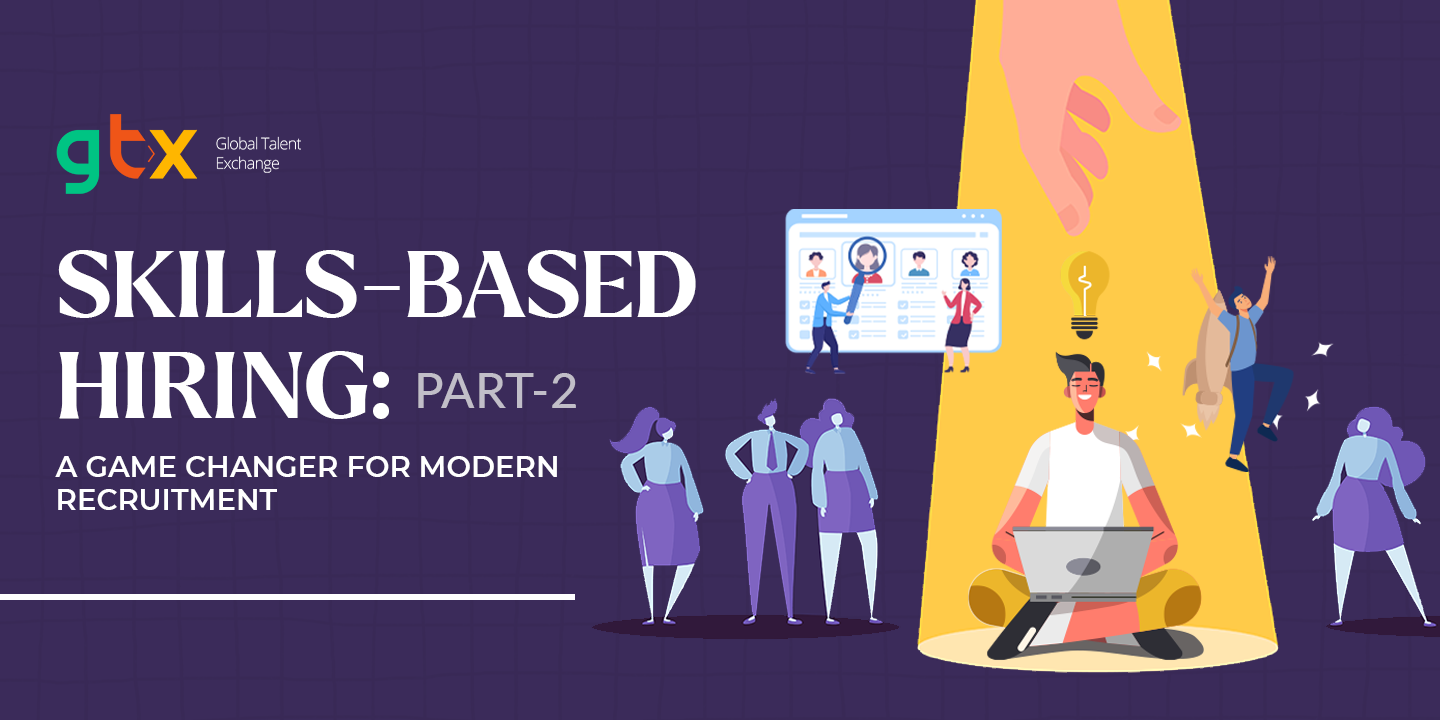Skill-based hiring, unlike traditional recruitment practices that rely solely on qualifications and experience, prioritizes skills and competencies that a candidate possesses to understand who might be the best fit for the team. It’s rightly termed as a game-changer, as more and more organizations are understanding that the most skilled talent needn’t hail from any one particular background.
In Part 1 of this blog, we explored the concept and discussed what skills-based hiring entails and the benefits it offers to the corporate world. We also touched upon the potential challenges it possesses along with some helpful tips on how to overcome them so it serves as an effective tool for recruitment.
However, with that, we barely scratched the surface of what this concept really means. It’s time to delve deeper.
Skill-based hiring might be well-known today, but unfortunately, not many know how to leverage it. Discover the secret to a wider talent pool, stronger teams, and long-lasting success. Read on!
THE EVOLVING HR ROLE
Skill-based hiring is proving to be revolutionary for recruitment which is also having a significant impact on the role of HR and talent acquisition professionals, reshaping their responsibilities and elevating their status within organizations to assume leadership positions.
This can be seen through the way HR leaders are now taking a much more strategic approach to workforce planning, utilizing data and analytics to identify skill gaps within the organization and plan their recruitment programs accordingly. It’s no longer a matter of how many hands are needed on deck; it’s about going the extra mile to understand where the organization’s teams might be lacking in terms of experience, knowledge, and skill compared to their competitors and the wider market. According to a report by McKinsey, Organizations that realign HR processes to match skill needs can boost employee engagement by 50 percent, lower training and development program costs by 50 percent, and raise productivity by 40 percent.
According to studies, HR professionals are also becoming more involved in the “people” aspect of their role, focusing more on developing the potential of their employees to further grow their competencies, which ultimately leads to better performance and enhanced financial results.
Skill-based hiring is, without a doubt, more challenging than the traditional route. It involves delving deeper to understand the candidate’s exposure, experience, and capabilities within a very short period of time, and posing relevant questions to evaluate whether they’d be a good fit for the position. For this, technology is a boon; it can be used to track applications, construct relevant “tests”, and evaluate each candidate to improve the overall accuracy and quality of the selection process.
The adoption of skills-based hiring has also elevated the status of HR professionals within organizations. Rather than being viewed as administrators, they are now recognized as strategic partners that play an important role in driving the success of the organization.
BUILDING A BETTER WORKFORCE: BEST PRACTISES FOR IMPLEMENTATION
As mentioned earlier, skills-based hiring might be highly sought after due to the excellent results it yields, but it can be challenging to navigate. We’ve identified and outlined a few of the best practices for effectively incorporating this concept into your talent acquisition process.
- Carefully define skills and competencies:
How can you hire the skills your team needs if you’re unaware of what is lacking? It’s important to frequently conduct in-depth analyses and reviews to identify if the organization has what it needs, which can be done by collaborating with managers and other relevant stakeholders. You’ll find this makes your recruitment process targeted, focused, and purpose based.
- Construct clear job descriptions:
Once a skill-gap analysis has been conducted, it’s fairly easy to construct a detailed job description that can help narrow down the applicants that come forward as they know what is expected of them since your requirements are specified and emphasized clearly. According to a report by BetterUp, doing this improves your hiring process, empowers your staff, and ensures that human resources professionals invest lesser time and energy in filtering suitability.
- Utilize objective assessments:
Traditional hiring practices would normally involve a careful analysis of the candidate’s educational experience along with a one-on-one discussion. Skills-based hiring takes it to another level, and there is a need to utilize objective assessments such as work simulations and tests to properly evaluate competency. For important roles/niche positions, these assessments are often tailed to the job description and pose scenarios and problems that the candidate would probably run into frequently in their daily job. Solidify your decision by utilizing some important behavioral questions as well to evaluate past behavior and performance; this could help guarantee a cultural fit as well.
- Utilize candidate scorecards:
If you’re interviewing for multiple positions with multiple applicants, it’s going to be tough to keep track of all this data. Consider using a candidate scorecard tool that lists the skills and competencies you’re seeking along with a scoring area based on their performance during the conversations and tests. It helps to effectively compare candidates and make a fair, objective decision. Here’s an in-depth article by Lever that outlines the benefits of doing so: How an Interview Scorecard Can Help You Hire Smarter - Lever
- Never stop improving:
With the kind of rapid change we’re witnessing in the world today, there are no processes or systems in the workplace that should remain the same for too long. It’s important to regularly review and improve the recruitment procedure as well to ensure you’re getting the best results, driven by past experience along with the latest trends that are gaining prominence.
THE NEW AGE OF TALENT ACQUISITION
We’re ushering in a new era, a changed talent acquisition landscape, driven by skills-based hiring and other transformative trends and practices. Here’s how.
- Competency-based hiring allows organizations to showcase their commitment to attracting and developing skilled professionals, which helps portray them as an employer of choice for top talent. Organizations can differentiate themselves from others and portray their company image as forward-thinking and innovative.
- Skills-based hiring also helps build a more diverse and inclusive workforce. When you focus on de-prioritizing educational backgrounds and “big names” in the resume, it helps you unlock a vast, overlooked talent pool across borders.
- Employee development and retention witness a dramatic increase when you start recruiting for skills in your team. You’ll have on board people who are there because they love what they do and are driven by a powerful sense of purpose; combined with proper opportunities to grow and develop further, you have on your hands a team that is there for the long run and is just as invested in the success of the organization as you.
TOMORROW’S TALENT, TODAY
The future of skills-based hiring appears bright. Organizations worldwide are recognizing the immense value of this approach and its potential to revolutionize the way talent is identified, acquired, and nurtured. Here are some key trends that are likely to drive its growth even further.
Rise of Artificial Intelligence (AI) and Automation: With advancements in machine learning algorithms, organizations can leverage AI-powered tools to efficiently assess and match candidates' skills with job requirements and identify the most suitable based on their demonstrated competencies. This not only saves time but also minimizes bias in the selection process, leading to fairer and more inclusive hiring outcomes.
Data-Driven Decision-Making: In the future, data-driven decision-making will play a crucial role in skills-based hiring. Organizations will increasingly rely on data analytics to identify gaps, predict future talent needs, and optimize workforce planning. By leveraging comprehensive talent data, organizations can align their recruitment strategies with market demands, ensuring they have the right skills at the right time.
Continuous Learning and Upskilling: In the rapidly evolving job market, skills can quickly become outdated. Forward-thinking companies are investing in robust learning and development initiatives to cultivate a skilled workforce that can adapt to changing demands. Skills-based hiring will go hand in hand with ongoing learning and upskilling programs, creating a dynamic and agile talent ecosystem.
Remote and Global Workforce: Skills-based hiring enables organizations to tap into talent from anywhere in the world, transcending geographical boundaries. Remote work arrangements will likely become more prevalent, allowing companies to access a diverse range of skills and perspectives. Virtual collaboration tools, augmented reality, and virtual reality technologies will facilitate seamless communication and collaboration.
Soft Skills and Emotional Intelligence: While technical skills remain crucial, the future of skills-based hiring will also emphasize the importance of soft skills and emotional intelligence. As automation takes over routine tasks, human skills such as creativity, critical thinking, adaptability, and empathy will become highly valued. Organizations will seek candidates with a strong combination of technical proficiency and interpersonal skills, as these qualities drive innovation, collaboration, and effective leadership.
Want To Know More?: The Recruiter’s Handbook To Hiring In 2023
UNLOCK SKILLED GLOBAL TALENT WITH GTX
The biggest war in the corporate world right now is the war for talent. Skilled and experienced tech talent.
At Global Talent Exchange, we are uniquely positioned to help organizations overcome the challenges of skills-based hiring. With a focus on connecting employers with qualified candidates from tech hubs around the globe, we leverage advanced technology and data analytics to match organizations with the right talent for their unique needs.
In addition to this, we also go the extra mile to support you in areas of employer branding, diversity and inclusion, talent pooling, and networking. Our solutions are formulated to ensure you emerge as a leader in the industry and dominate the game.










